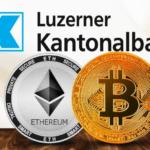Highlights
- Demand is rising for portfolio diversification beyond stocks and bonds, with gold reaching new records and bitcoin adoption widening.
- As the Fed begins a likely extended rate-cutting cycle, finding yield in alternatives has become more important.
- Wall Street firms, including BlackRock, are launching covered call ETFs in gold and bitcoin, but experts caution these income overlays trade off upside gains and traditional safe-haven protection.
Gold prices keep hitting record highs, while bitcoin, despite struggling to stay above $100,000, continues to gain mainstream traction. Beyond acting as traditional hedges, both assets are now being used within exchange-traded funds (ETFs) to generate income, thanks to new strategies that combine exposure with options overlays.
Investors are seeking diversification away from stocks where gains are concentrated in a few mega-cap tech names and bonds, which have proven more volatile than expected. While alternatives like gold and bitcoin don’t naturally provide yields, attaching income overlays helps them mimic the steady distributions associated with fixed income.
“Gold can act as a haven during market volatility, while bitcoin has shown strong returns,” said Todd Rosenbluth, head of research at VettaFi, on CNBC’s ETF Edge. “Now, covered call strategies on these assets are becoming popular for those seeking income.”
Wall Street Steps In
This week, BlackRock, the world’s largest asset manager, filed for a bitcoin premium income ETF, showing growing institutional interest. Smaller players like Simplify Asset Management have already launched the Simplify Gold Strategy Plus Income ETF (YGLD) and the Simplify Bitcoin Strategy Plus Income ETF (MAXI), which pair futures exposure with options strategies to generate payouts.
According to Simplify’s Paisley Nardini, investors moving money from bonds into these ETFs can still target attractive yields without losing income potential.
Other products, like NEOS Investments’ Gold High Income ETF (IAUI), also use covered calls on gold, with IAUI already holding over $115 million in assets.
Performance Snapshot
- MAXI (bitcoin income fund): YTD return 12% vs. 17% for the core iShares Bitcoin Trust (IBIT); 12-month yield above 43%.
- YGLD (gold income fund): YTD return 69% vs. 42% for SPDR Gold Trust (GLD); 12-month yield around 5%.
Despite lagging on pure price gains, these ETFs attract attention with high yields.
Trade Offs and Risks
While these income generating overlays satisfy investor demand, experts warn they limit upside capping bitcoin’s growth potential and muting gold’s safe-haven role. Still, for retail investors, the income appeal can outweigh the drawbacks.
The trend reflects a broader ETF movement: income focused products like JPMorgan’s JEPI and others tied to portfolios of star investors (like Buffett and Ackman) are expanding rapidly.
As Rosenbluth notes, bringing covered call strategies into ETF form highlights the efficiency and accessibility of ETFs as the preferred vehicle for new investing approaches.













